
German born Vanessa Paschakarnis migrated to Nova Scotia before coming to Pietrasanta in northern Italy. Hers is a philosophical approach to sculpture.
I met Vanessa through Californian photographer, Gail Skoff, who took a special series of photos of Vanessa, which you can see on this page.
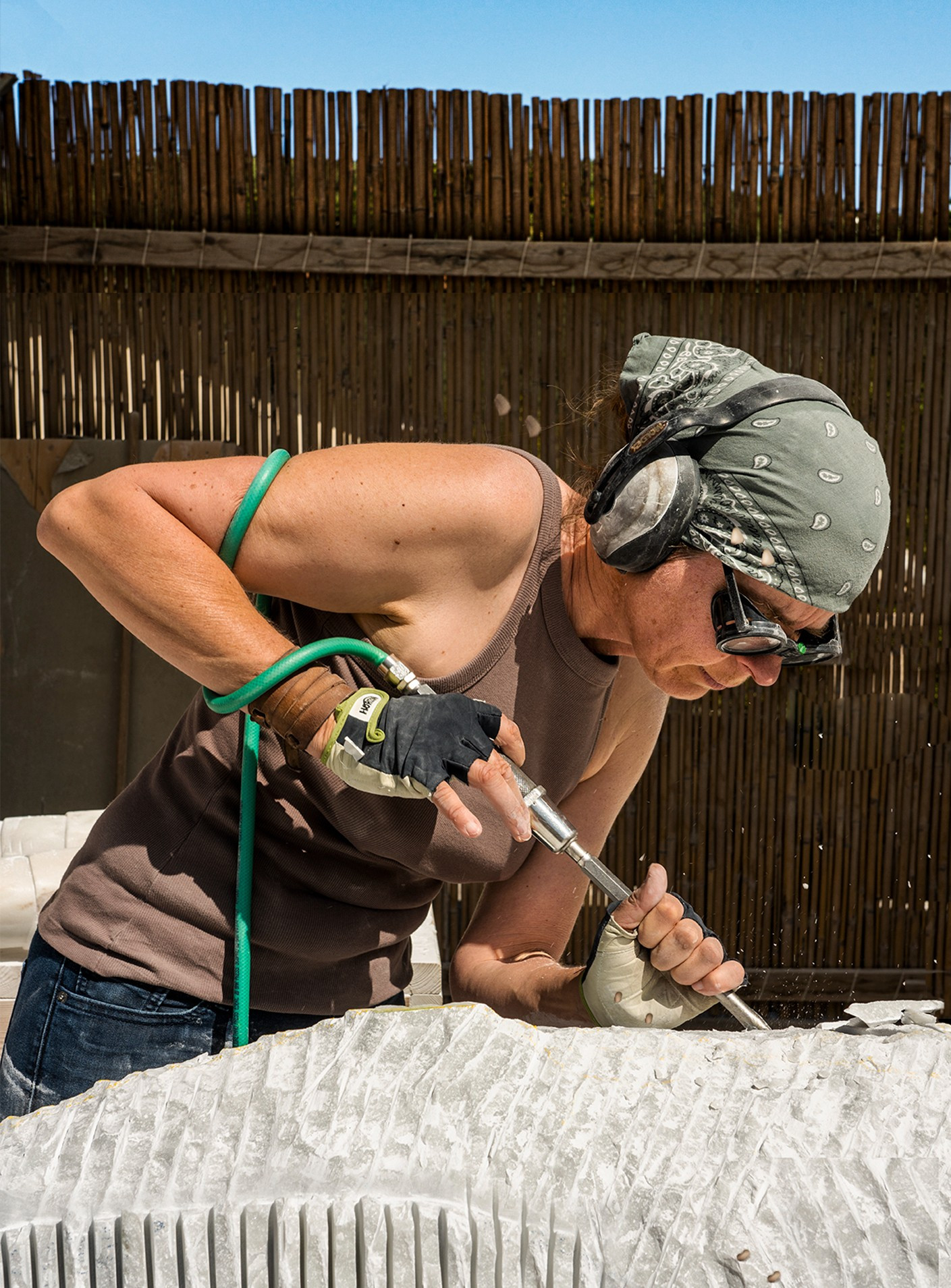
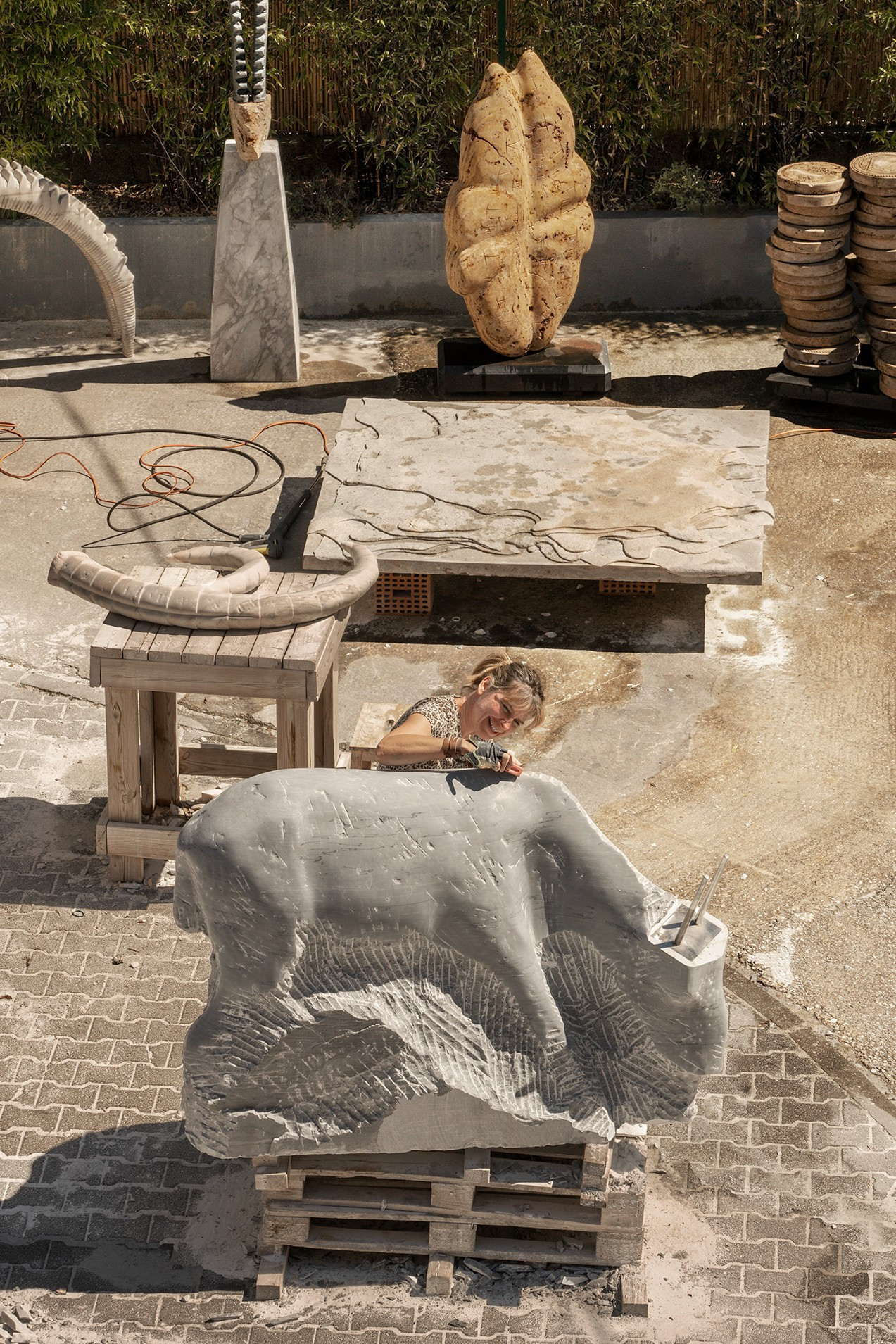
Hand finishing Anapnoí
In front of her studio-home is a dusty yard filled with her work. She works in large series’ and themes include horned and winged beings, beasts, and shadows.
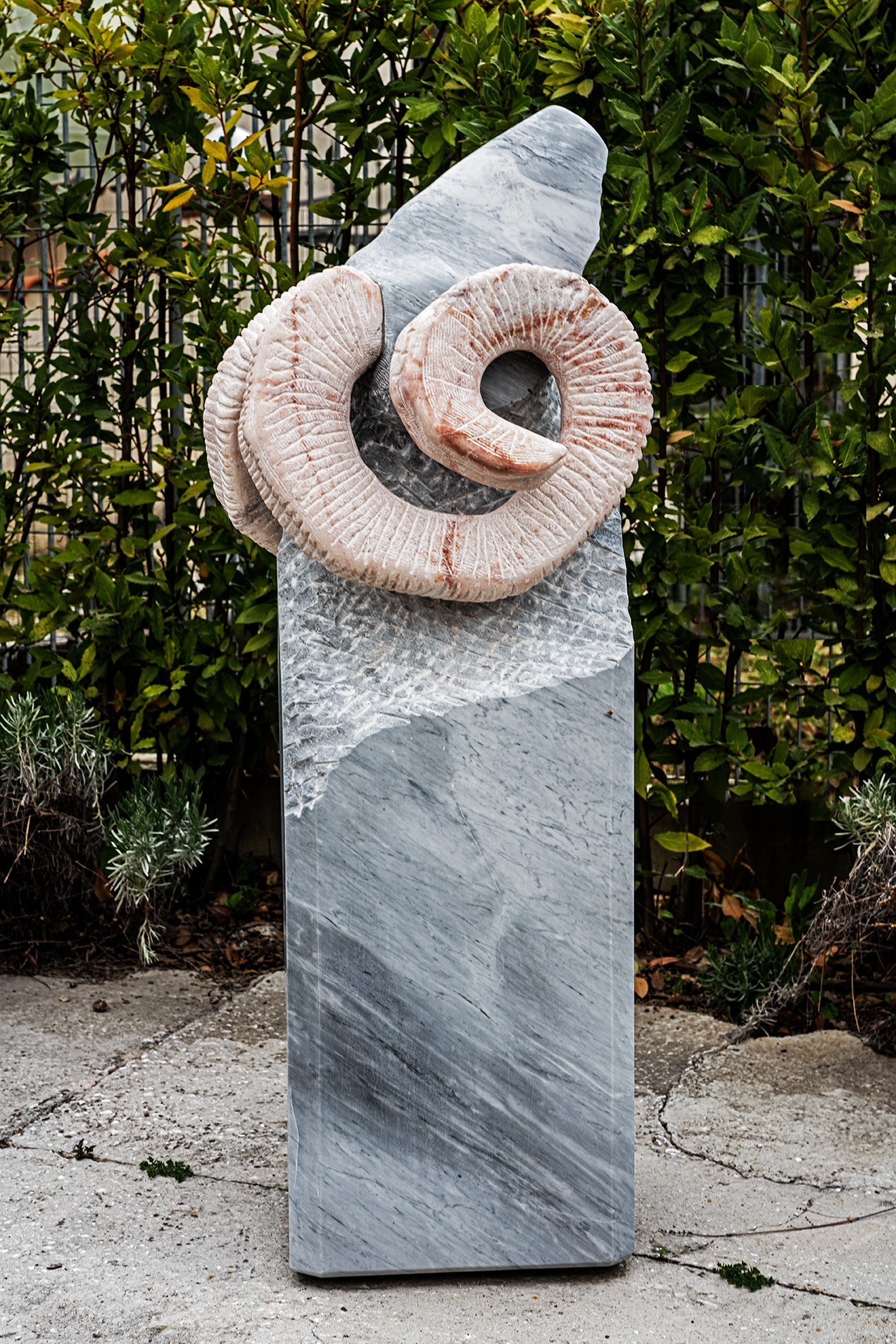
Horned Being (Vulnerable), 2021, Bardiglio marble, Rosa Portugal marble, 60 × 52 × 147 (height) cm

Horn for Anapnoí
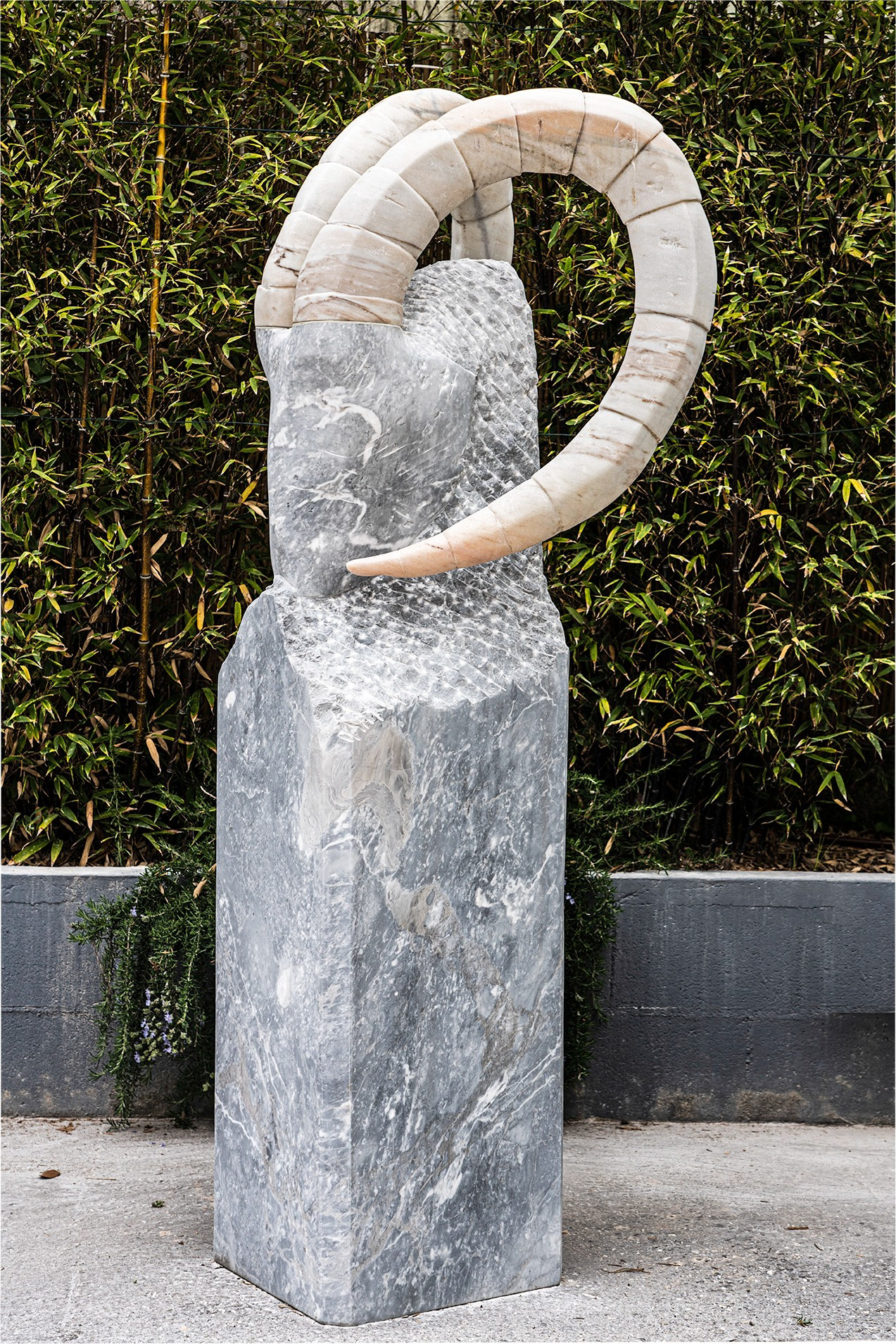
Horned Being (Bestia Umana), 2020, Bardiglio marble, Rosa Portugal marble, 70 × 60 × 184 (height) cm
Behind us is the large hangar-like industrial building with huge windows, which is being transformed into studio space for her and her husband, sculptor John Greer.
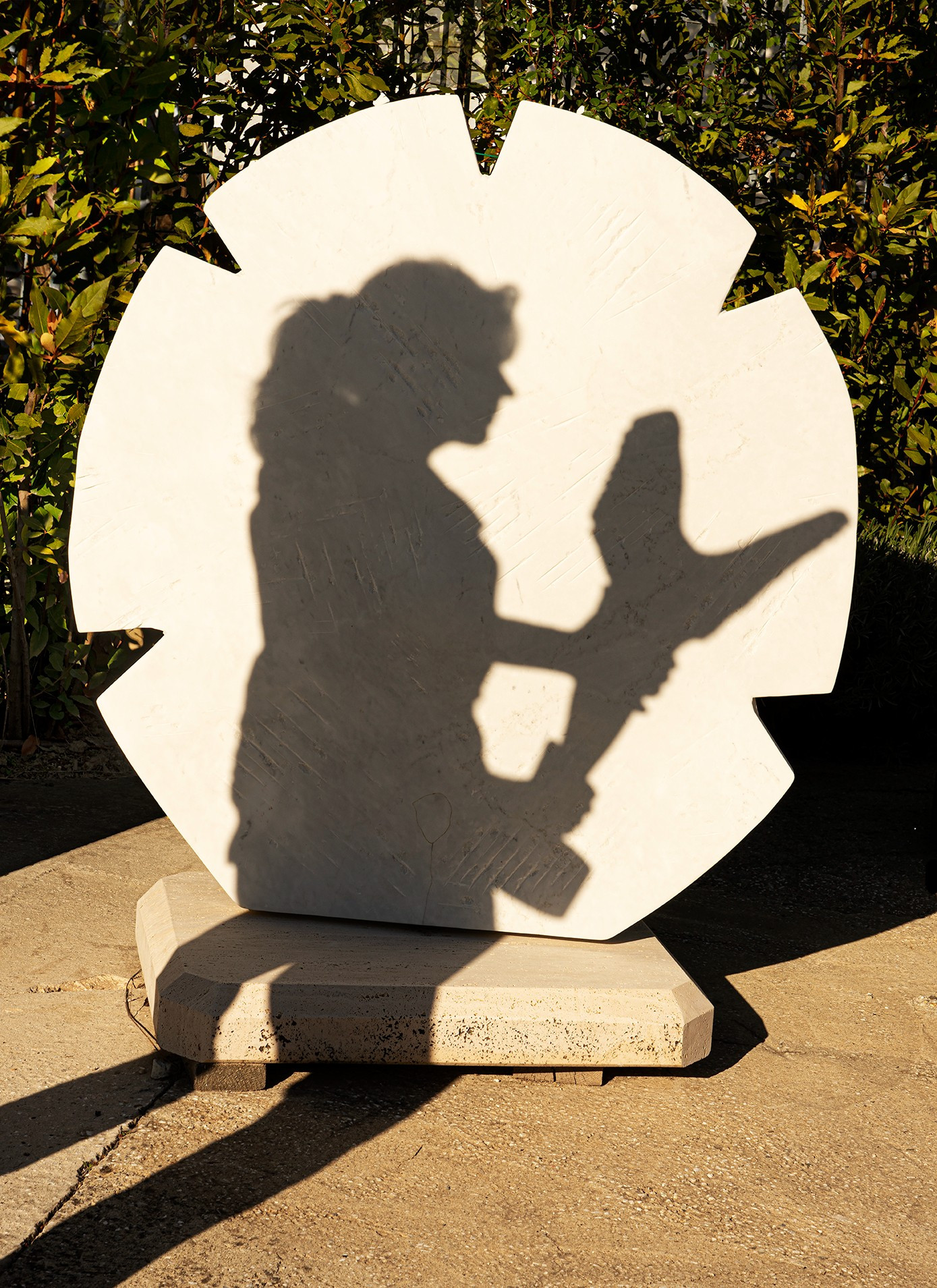
Shadow of the Guardian
Vanessa is hugely inspired by nature and we settle to chat in a small oasis of flowers and water – where a pond, fed by a stream is home to fish and frogs. I also meet her spectacular Bengal cat, Tarzan von der Saffenburg.
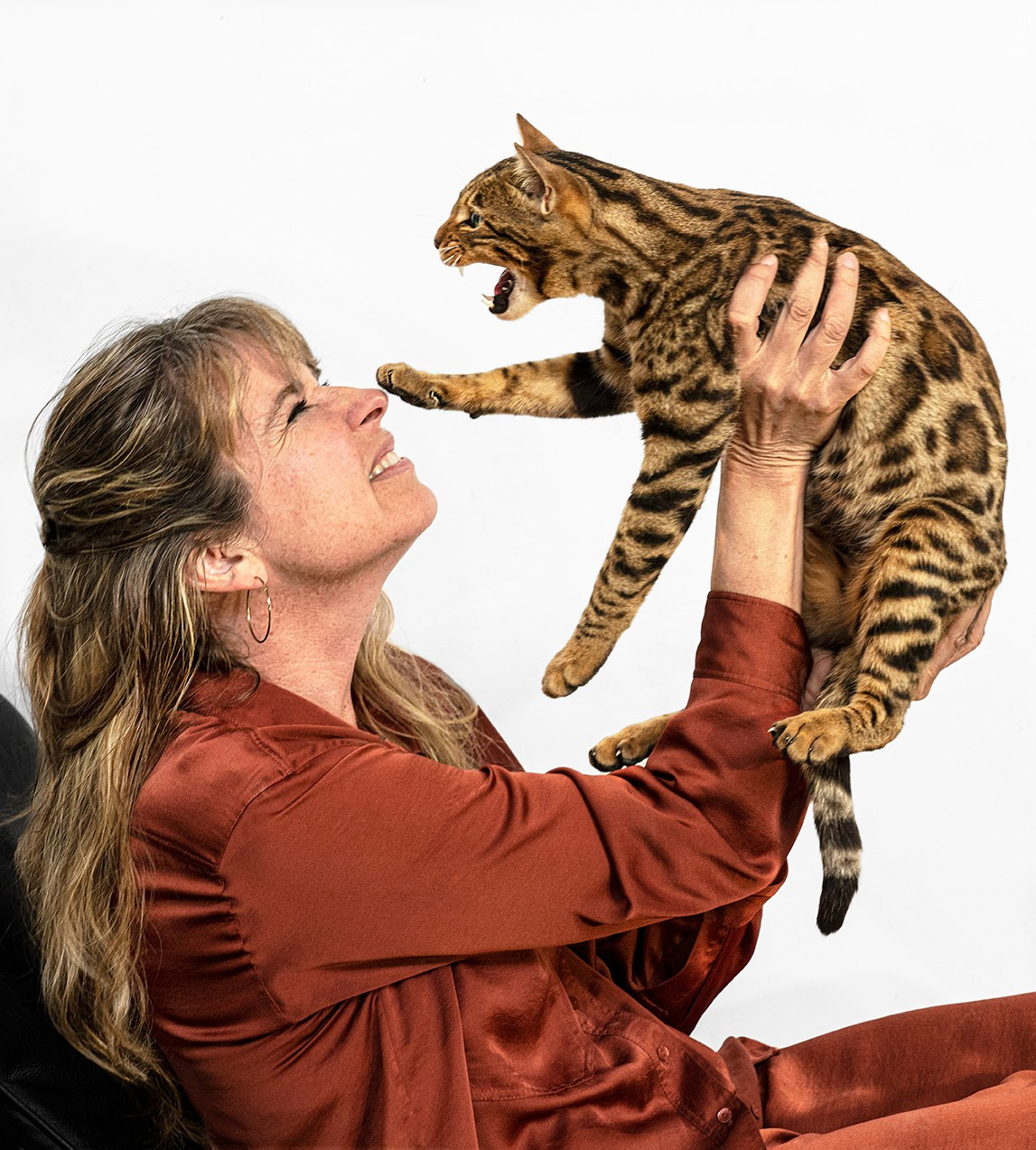
Vanessa and Tarzan
Thanks to Gail Skoff for this collaboration and the fantastic photographs of Vanessa.
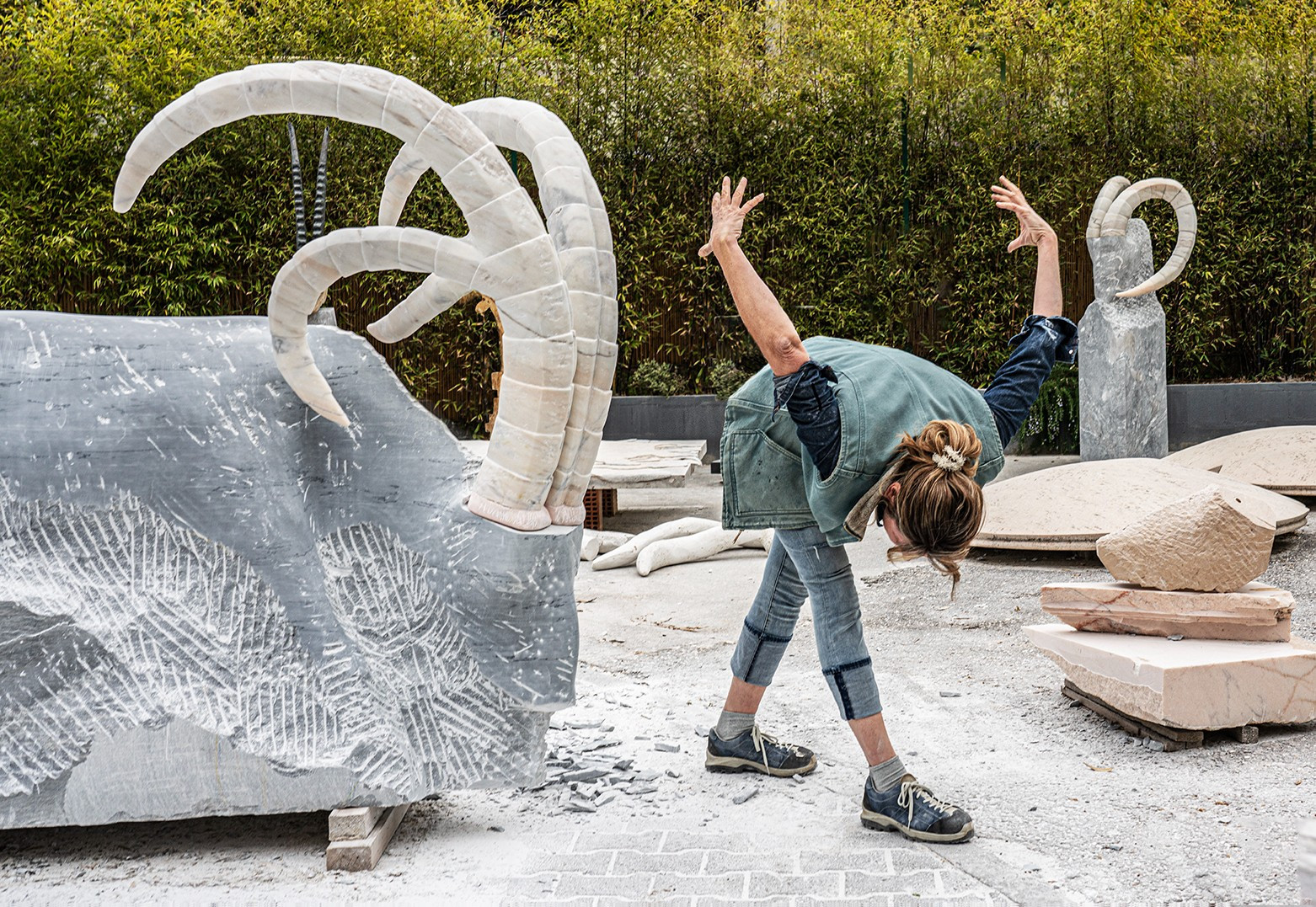
Vanessa bowing to the 'gods' with Anapnoí, 2022, and Horned Being (Bestia Umana), 2020
All photos by Gail Skoff: gailskoff.com – instagram.com/skoffupclose
Credits
Producer: Sarah Monk
Sound edit/design: Guy Dowsett
Music: courtesy of Audio Network
Cotton Wool 3577/005, David O’Brien and Paul Clarvis
Well, I guess that it’s all about for me about how you relate to to the world in large, you know, and how how to to give you a platform to unlearn the known, you know, because a lot of my work works that way. It’s very raw things. It’s raw surfaces. They almost look unfinished. Right?
Vanessa Paschakarnis:I always say, I want you to look with your knees, see with your elbows, and feel with your eyes. That’s how you connect with sculpture. You realize that all your experience is important to inform your experience in this very moment. Very much the kind of existential thought, right, and very much a philosophical approach to sculpture, right?
Sarah Monk:Hi, this is Sarah with another episode of Materially Speaking, where artists and artisans tell their stories through the materials they choose. Today, I’m meeting Vanessa Paschakarnis, who was born in Germany, migrated to Nova Scotia, and is now building a new studio, along with her husband, John Greer, near Pietrasanta in Northern Italy. I met Vanessa through Californian photographer Gail Skoff, who has been photographing artists around Pietrasanta while I’ve been interviewing them. I find Vanessa in front of her studio home in a dusty yard filled with large sculptures. There were some horned and some winged beasts, a shield, and several pieces nearing completion.
Sarah Monk:Behind us is a large hangar like industrial building with huge windows and evidence of building works in progress. We settle to chat in a small oasis of flowers and water, where a pond fed by a stream is home to fish and frogs. Vanessa feeds the fish and I ask her to introduce herself.
Vanessa Paschakarnis:My name is Vanessa Paschakarnis, and I’m a German Canadian artist living in Italy and Canada, which is just about to change a little bit. It’s gonna be more Italy than Canada. As a German, I immigrated to Canada. And now, I’m coming back to Europe and, building this big studio here with with my husband, in Pietrasanta. And, yeah.
Vanessa Paschakarnis:So that’s why I’m right now mid mid career, mid life. Not a crisis, a reevaluation. All good. Yeah.
Sarah Monk:So where were you born then?
Vanessa Paschakarnis:I was born in Germany, in Southern Germany, in Franconia, part of Bavaria, where good wine comes from. I grew up very dedicated to to that region, then when I was 10, we moved further up in in Germany. Then I was in North Rhine Westphalia, in a small village. Wonderful experience. I had a horse and a dog and stuff and two sisters and very liberal parents.
Vanessa Paschakarnis:And I lived between Castle and Munster, between the the documenter and the sculpture, sculpture projecte. And so so I was familiar with these big big, art exhibitions early on. Right? And and my father went with me even as a as a young girl to see those. Were your family artistic?
Vanessa Paschakarnis:Not at all. No. I’m not from an artistic family. My father was an engineer, my mother a housewife, but but my father was always interested in art and he had a distinct taste in art. He went to exhibitions and and knew what he was looking at.
Vanessa Paschakarnis:And and he loved drawing and he taught me drawing really, which was kind of an interesting thing as an engineer. He he thought about becoming an architect at some point, which he didn’t, but both of my parents were were refugees, Germans that were from my father from Lithuania. That’s where my name comes from, and and that’s why I really didn’t wanna change it. Paschakarnis is Lithuanian. Born as a German, really, in Lithuania, and and my mother was from is from Breslau, which is now Poland.
Vanessa Paschakarnis:Born as a German there, and during the war, they both as kids, as little kids, had very traumatic refuge refugee stories as they you know, my mother was in one of those famous cattle trains, my father as well, his mother walked to with his sister and him to Germany, and they were in refugee camps, and then they started over, you know. So it’s kind of a generation. My parents have come from that what they call in Germany, the lost generation because they were German kids that weren’t wanted in Germany. And there was never any, you know, it’s like, you’re German, you’re you have to deal with it. Everything is normal for a kid anyways.
Vanessa Paschakarnis:Right? But anyway, so I that that’s my parents, and I had a wonderful childhood. My father was a very smart man and a wonderful man. We were kind of middle class type of thing, you know. But I think what was important for me was that both of my parents I had two sisters and I grew up not knowing about gender issues.
Vanessa Paschakarnis:That really came into my life when I moved out because, you know, I just I just grew up. My father raised us. We were we were humans and not, you know, there was not you can only do this as a woman and that as a man. You know, I grew up born in ‘70, so in the seventies. And and that made me very strong, I think.
Vanessa Paschakarnis:I never thought there was something I couldn’t do. You know, I just I always knew I was gonna do my thing, not and no matter who I marry or not, you know. And and I guess children were never anything I wanted anyways. But yeah.
Sarah Monk:That’s really interesting. So your your parents both came from different bits of Europe during the war to Germany. Is that right?
Vanessa Paschakarnis:Mhmm. Mhmm. Okay. My mother was born ‘38. And, you know, when when Hitler started the war, he called all the Germans back.
Vanessa Paschakarnis:And and so, like, my grandmother really fled from the Russians because they started to to flood Lithuania and and they would rape women, you know. Her her husband was already in in fighting in the war and he was in captivity, so she was alone. They were well off there. Yeah. So she took a little hand carriage and walked with a daughter, and my father was born in ‘33.
Vanessa Paschakarnis:So Hitler called the Germans back, and and the Germans weren’t really happy of taking in German refugees right from somewhere else at that time either. So it was hard for that kind of group. And my mother as well, like Breslau, her father was a police officer, so he knew what was coming. And before the big exodus in Breslau happened, he sent his family out in a train. To meet a family, they in a different country, they hope was there and they would get there.
Vanessa Paschakarnis:You know, it’s Yeah. Hard times. But they are Germans. Right? That’s the funny thing.
Vanessa Paschakarnis:And so I arrived in Germany and had to start over from from nothing. And But I think just I’ve been working through this in the last few years. I think what is really important for me and that’s that I don’t feel like I am of any place. You know, I like I don’t feel even in Germany early on, that’s why I learned English and French and I knew I was gonna I wanted to leave Germany just because it I felt it wasn’t I didn’t feel rooted there. And and then a place where I felt really at home was Nova Scotia.
Vanessa Paschakarnis:You know, I went there as an exchange student at first, and it it was the place that I was intrigued by. For me, it’s always first the place and the space and and as few people as possible. And now I’m here in Tuscany, where people are going for the people. Oh, yeah. Is fun. It’s life
Vanessa Paschakarnis:I did study art. Although it’s not easy to get into an art academy in Germany. And so you you have to be you you have to wanna do it because it’s adapt to to prepare that portfolio.
Vanessa Paschakarnis:And what was really important for me was in high school, there was two teachers that were really important for me. One was my French teacher who introduced me to philosophy. Existentialism in specific was something that really opened my mind to a lot of things. And it’s it’s really today part of the foundation of my work, this kind of continuous development of the self, the search for meaning. That was something that early on when I was 17, 18 in French language, I would read Camus and Sartre Simone de Beauvoir.
Vanessa Paschakarnis:Very important for me. In parallel, I had a teacher in art that really gave me a wonderful foundation, And I learned about, you know, this is the the mid eighties and, you know, all the important art movements I I already understood and talked about in high school. And I remember there was a class when she introduced us to Yves Klein and showed us a lot of a lot of his work and the idea of new realism, of a realism that has nothing to do with a picture plane, nothing that has to do with the experience of the material world. The void being a fullness. The color being so powerful it’s a physical sensation.
Vanessa Paschakarnis:Yves Klein Blue, the living brushes. I remember when I was introduced to that at the time, that just blew my mind and it was like wow because I always liked drawing and and and this idea of of realism being a thing, like of life and art being one. That opened up to me at that early time, and so I think I was fortunate and then I was really determined. I went home, I said to my parents, this is what I want to do. My father just looked at me and said, well, I think it was always an option.
Vanessa Paschakarnis:Go for it. You know? And so I had full support from both my parents really. And then I tried applying for art schools, art academies in Germany, and it’s really hard to get in. I applied and got rejected, and then I went to Berlin to study geography.
Vanessa Paschakarnis:Because I thought, well, if I don’t even get in, I’m not gonna waste my time. So I actually moved to Berlin, and then when I had I went twice to to my geography classes and then I found right around the corner where I lived a school that was called the Freie Kunstschule Berlin And it was a place where the first time was immersed in something like a studio activity. Erwin Lieber, my teacher at the time, he he was a sculptor turned painter later on. He kinda circled my my drawing board and he said, well, is this the first time you’re doing this? You know, I said yes.
Vanessa Paschakarnis:He kind of was the one to who, signed up for my first sculpture class and it just was my thing. And he was the one who would after two two courses of mold making, he’d he’d say, okay. I have to leave now for an hour, but if you have questions, just ask Vanessa. And he didn’t, you know, he didn’t before kind of consult with me or ask me or anything. He just threw me in there and it was and all of and the thing was I could answer all the questions and I had fun and yeah.
Vanessa Paschakarnis:And then he said, Vanessa, look at you. Just the way you dress. You are a sculptor. You are not a painter. With the right mentors, I kind of really started making my way into into the work that that I’ve been pursuing.
Vanessa Paschakarnis:And I think in a way I mean, coming to art from from the intellectual perspective. Right? It’s not I didn’t find stone and and kind of love the stone. I came to it from a very different way. I was I was really immersed in, like, what I was interested in as a student was minimalism, know.
Vanessa Paschakarnis:It was Atepuwara, it was conceptual art. So it was I looked a lot at the the painting at the time. You know, in Woden, there was a lot of of new painting in Germany as well. I ended up studying in first year in Dusseldorf, then I went to Stuttgart because when I was accepted after one year in that independent school, I was accepted at two places. You have to be very independent and really, if you don’t know what you wanna do, you you have to leave because you you leave because you can’t know, it’s not like some say, for example, in North America, it’s all classes.
Vanessa Paschakarnis:You pick the classes and they kind of that way you go through. And in Germany, it wasn’t like that. You know? It’s like if you were you you have to be strong, you have to know what you want and kind of, really form your voice by by rubbing against other other voices in that class. And that’s well, it makes you strong too, right, in the end because, you know, if you are not if you are not interested in your own work and can’t talk about it, nobody else will.
Vanessa Paschakarnis:You know, mean, that is kind of I guess, later on you realize how formative and important those kind of years are. Right? In the end, I actually separated from Ingemann. This is funny too. It’s these two women.
Vanessa Paschakarnis:I wanted to work with a strong woman. Then when I got too strong, we got fighting. And I ended and ended up switching there. And as I followed her to Berlin First, so I studied in Berlin in the former East German Academy when when Germany opened up. And because they called a lot of professors from the West into the school because that was a very different model because there, you know, you were educated to make art for the state.
Vanessa Paschakarnis:And whatever we call art was done just at home under the table, know. And and so so that was big changes. Interesting time to be in Berlin, know, very very crazy place. And so I graduated in Berlin at that school in ‘97. In Germany, you do four years of academy.
Vanessa Paschakarnis:And then usually after the fourth year, we all went for a year somewhere else, an exchange program. I had met a Canadian in in high school, and, I knew Canada was a place you could immigrate to, where The States, I didn’t think it was a place that’s easy to even get in or so. Then they said, are starting a new program with NASCAD, which was at that point still the hotbed for conceptual art in the world. So it was kind of this hotbed of conceptual art, I said, well, that’s not so bad a recommendation. So so I went mind you, Halifax is kind of at the end of the world.
Vanessa Paschakarnis:Right? It’s it’s a it’s well, it’s it’s a very strange place because it was such a special place. I arrived there and I had been traveling a bit. I was in New York for a week and I and I arrived there and I’m like, oh, what did I do? But the landscape is so strong and it’s such such a special place.
Vanessa Paschakarnis:And NASCA turned out to be it it was twenty four hour access. It was these these old Victorian buildings all connected to make the school at the at the harbor front. And it was just so amazing. It was such a think tank. It was sort of my idea of kind of talking to others and working with others.
Vanessa Paschakarnis:And it was just such a wonderful experience that I So at first I came and I wanted to everything, you know, printmaking and and photography. And then I was there and I started hiking and I, experienced the landscape before the school started. And then I came back, I dropped all the classes, I said I have to do sculpture. This is my place here. I’ve come home.
Vanessa Paschakarnis:Nova Scotia, if you don’t know it, it’s a rock. It’s granite, very little soil, you know. It’s a peninsula And it’s nowhere you have more than 50 kilometers to the Atlantic Ocean. And it’s not it’s not sand, it’s just all rough rocks and you you it’s, you know, existentialism. You feel that, you know, you struggle for life.
Vanessa Paschakarnis:The trees are not thick and straight, they kind of are gnarly and go all in the direction of the wind. It’s a place so raw. And that was just my place. And I did a show called New Works, which was basically this room where where I put all these made boulders that that were small rocks. And it was the first time really that that I realized an exhibition, a solo exhibition with the idea of immersing the viewer in the field of experience.
Vanessa Paschakarnis:And this is still so much of of what my my thinking is. So I was introduced to casting there, aluminum casting, and I did all these rocks. They were all made, put there for you to engage with. And you would walk through, you would always be in it, you would not look at something on pedestal. And then I had drawings where I would roll a rock and trace it, you know, so it’s all about this tracing, about this memory, about about the movement of material on on paper.
Vanessa Paschakarnis:And these were on the walls, and it was was just another world I created, and and and it was very important for me. And that’s kind of then too where the shadows started to happen. When I worked with plaster and this graphite surface, the materiality was something that you couldn’t tell what it was. And that’s something, you know, with the shadows as well, you can’t really grasp it. And so I that was a material for me to realize shadows with.
Vanessa Paschakarnis:And then this whole idea about these boulders and about making forms that are just about being made, that about the history of me putting force on them and then putting them in your way to engage with them. This moment of encounter where you realize that all your experience is important to inform your experience in this very moment. Very much the kind of existential thought, right, and very much a philosophical approach to sculpture. Right? I went back and immigrated to Canada afterwards and did my masters there.
Vanessa Paschakarnis:And I did a show that I called Sculpture and I thought it was so radical because, you know, because it’s about the the thing as a confrontational other, you know, and it’s it’s a very basic idea of sculpture, but it so excites me. And I realized the shadows shadow is culturally something that you connect to some to darkness and to the other side of things. But I see it as occurring in the most you know, there’s light, that’s when shadow falls. And it is a confirmation that you’re here. Unlike a, a reflection distorts things, a reflection turns things around where a shadow intensifies what’s there.
Vanessa Paschakarnis:So it’s a different it’s a different thing and for me in a way it’s a really positive thing and and it’s, if you can grasp a shadow as a three-dimensional thing because, I mean, you see it on a surface, but it’s there. If you pass behind somebody, you are in the shadow. So that’s when my shadows became the boulders. And I made this landscape. I went back to Germany and I did two exhibitions for my masters.
Vanessa Paschakarnis:I did the one with the five shadows. I had this giant studio. And I did these large plaster boulders and just placed five, a bit larger than than human size. Mean, that my measure for most of my things is really the body, my body in that case, what I what I can reach and grasp or like relate in relation to my torso, my head, my arms, and my legs, you know. So I always say, I want you to look with your knees, see with your elbows, and feel with your eyes.
Vanessa Paschakarnis:That’s how you connect with sculpture. So I did the show of the shadows and I didn’t realize, you know, a lot of people really it takes them a while to to wrap their head around a shadow being a thing.
Sarah Monk:So then you settled in Nova Scotia. You decided to become a Canadian.
Vanessa Paschakarnis:Is that Well, yeah. At that time, I immigrated to do my masters there. I was actually married to a German guy at the time. Divorced since. I didn’t really want to teach, but I ended up teaching and I loved it.
Sarah Monk:What did you love about it?
Vanessa Paschakarnis:The discourse with the with the students, you know, like you have these smart young kids that that are eager to express themselves and it’s a challenge, you know, because really you have to lead them to do their own thing. And so you have to be open and and as a German rigid mind, it took me a while. I mean that’s really what kind of right now I’m missing. That that discourse, you know, that constant kind of reevaluating. Why art is important now?
Vanessa Paschakarnis:Why would you lead somebody on the way? And why are you there? You know? Those are basic questions that that I always found fascinating.
Sarah Monk:And can you tell me about the connection to Italy and when you first came to Pietrasanta?
Vanessa Paschakarnis:It was really because because of the possibilities working with stone and bronze. The first time I came is actually it’s exactly twenty years ago. And and I had a teaching position for the University of Georgia in Cortona as a sculptor professor for the summer. John said, well, if you go to Italy, you have to come here and do your own work before. When I came here and I ordered this giant stone, it was kind of a crazy experience too because it was a two meter 40 by one fifty by 45, and I carved this one big fossil wing being in this gray bardiglio.
Vanessa Paschakarnis:And I had a month and six days a week from morning to night, I would carve and this and I was kind of very nervous because I was this young woman coming and these guys kept watching me and the stone was so hard. It was like carving iron. It was like the sound and this bardillo. It was this this fresh bardillo that really was so hard to carve. But it but I pulled it off and I did it in four weeks and I guess I had a wonderful time, and I gained respect here too.
Vanessa Paschakarnis:And so it was a natural for me to come back then.
Sarah Monk:Was that first wing piece a commission, or was that an idea you wanted to realize?
Vanessa Paschakarnis:It was just something I really wanted to do. It actually is now in a private collection in Switzerland.
Sarah Monk:Can I ask you more about the inspiration of winged animals or wings?
Vanessa Paschakarnis:What what’s I get I get a lot of my inspirations from natural forms. And the wings really started with with fossils. You know? So as and my guardians as well. Fossils are for me something really fascinating because here we go again with the existential thoughts.
Vanessa Paschakarnis:Right? For me, they are a connection to to being part of the world. And it’s an interesting thing because I feel like as a human, we have a need to engage with the other, and we are trying to make sense anything mineral or animal and our relationship to it. And so so I see these things and then I wanna see them in in a more human size or just slightly larger than human size. And and for me to make a winged being out of out of stone in that size, it’s about the desire to fly and being grounded on the earth.
Vanessa Paschakarnis:And I mean, that’s something very basic we all know about, you know, looking at the clouds, at the birds, and being firmly grounded.
Sarah Monk:I was wondering if I could ask you, what would your eighty year old self advise you to do now?
Vanessa Paschakarnis:My eighty year old self?
Sarah Monk:Yeah.
Vanessa Paschakarnis:Already when I was younger, people were impressed with the quality and the level of my work, but somehow I didn’t fit in in many places. And that’s an odd thing, but but I think in our world now, that might be a good thing too. So so I think my eighty year old self is telling me embrace life and and open up and and be happy with what you achieved instead of trying to figure out, you know, don’t be so German. Just let drop sometimes to the efficiency and don’t feel guilty when you take time off.
Vanessa Paschakarnis:So I work in large series where I have the the shields and I have the winged beings.
Vanessa Paschakarnis:I have the beasts. And a lot of these works, they happen side by side or they kind of evolve. For example, the beasts in general. The beasts, the way they started was when I was in Greece and I saw this head of a lion in a very light colored marble. And I went back and I did a series of work called the domesticated beasts, and they are all based on animal heads of domesticated animals.
Vanessa Paschakarnis:However, the way I get to my form is I go out and find a natural form that reminds me of it. So so the pieces really look they could be found objects, but they are very distinct, like people look at them and see see animal heads. But they are made in Rosa Portugale, which is used to depict Caucasian human skin. Right? So so they are they are just these heads, these raw, like, raw heads, but they they look like flesh, like human flesh.
Vanessa Paschakarnis:And one thing, I guess, too, with really all my work is that that I’m not interested in in finishing the surface, polishing it or so. I for me, all my work is about a skin a skin wrapping a volume. So it’s all about you seeing me carving this and about, being aware of of how it came into being. And, as a skin, it shows wear and tear. So so my work is like I carve right to the surface and then I smooth it out and I keep it so that it’s soft to the touch, but it but it looks raw and often I leave really rough edges on the pieces, undersides.
Vanessa Paschakarnis:So these domesticated beasts was a a series that I did. And then, and then I got good thinking and then, the the shadows came again and I made molds of these, and I doubled them up in a black opaque kind of material called winter stone. So there were these shells that doubled up and were the shadows of domestication. And then I went to Budapest and I saw the Monument Of The Huns where the horses, had bridles made of deer antlers. Full circle for me because a domesticated animal becomes the beast.
Vanessa Paschakarnis:Right? So it becomes a weapon. I was like, woah. So I did a show where I had all these animal heads that had either, you know, like a bull head with the eyes covered, and then I had the horse head with the bridles, just but just the heads, just the the the animal heads. And then from there, I was kind of going on, and I was rethinking, and I was thinking about the wild.
Vanessa Paschakarnis:And and that’s when the horned creatures came in. And the horns are like arms or like snakes, you know. So they are very much like these creatures that I want you to think of, but you can’t really pin it down. And and so they rest in a space where I hope you relate to them as just the other and then kind of fill that void with with your own experience and reevaluate your own experience against this thing that I put in your in your in your way. It’s it’s excites me when it when it it ends in a place where I look at it and say, oh, I don’t I don’t even know how I got there.
Vanessa Paschakarnis:You know? Like, did I make this? Now it it works by itself. Right? So and when I get more than out of it than I put in, that’s that’s an exciting thing for me.
Vanessa Paschakarnis:You know, this whole idea, I see something in the stone. No. I put my idea into the stone. You know, because, again, because I stop where other people still have a lot of time because they wanna have the perfection of the surface. I don’t seek that kind of perfection.
Vanessa Paschakarnis:The perfection is somewhere else for me. It’s it’s it’s in the presence afterwards. I feel like you need to enter through the surface. If you if you polish a stone too much, it closes off. And I like my pieces to be open enough that you that you wonder, that you wanna wanna touch.
Sarah Monk:So thanks to Vanessa Paschakarnis. You can see her work on her website, sculpturebyvanessa.com, or on Instagram @vanessavip . Thanks to Gail Skoff, whose photographs of Vanessa can be found on our website, materiallyspeaking.com, and on Instagram. You can also check out more of Gail’s work on her website, gailskoff.com, and of course on Instagram @skoffupclose. Thanks for listening.
Sarah Monk:And if you’re enjoying Materially Speaking, subscribe to our newsletter on our website so we can let you know when the next episode goes live.